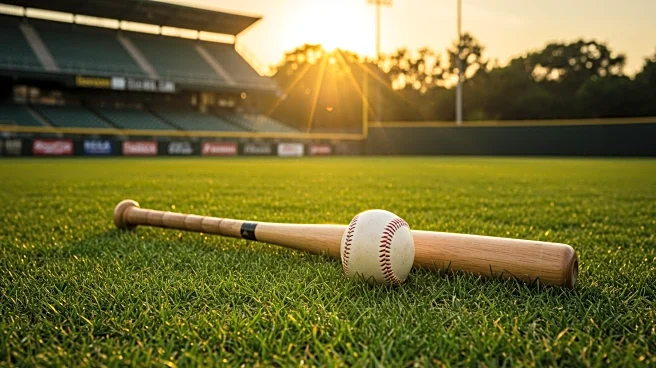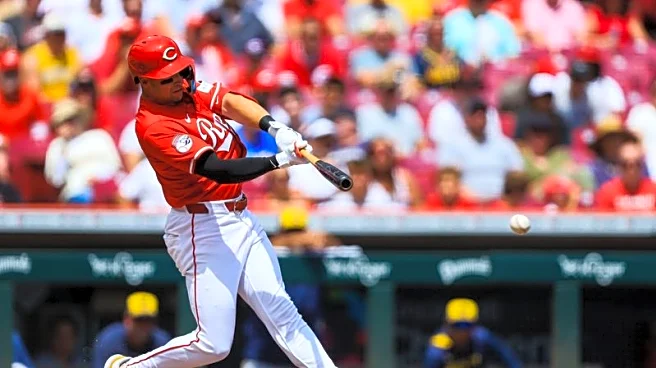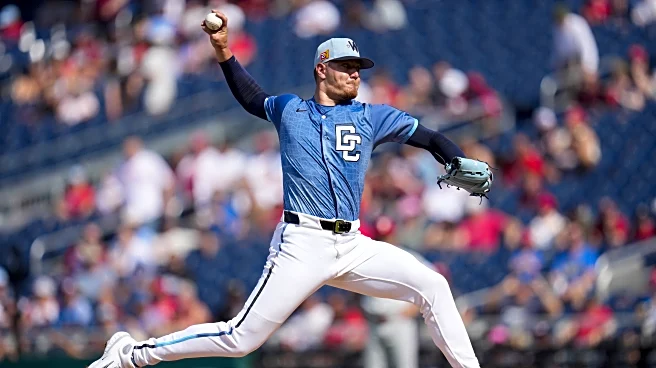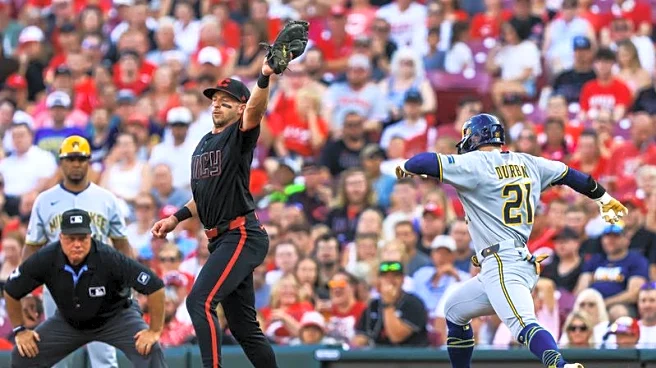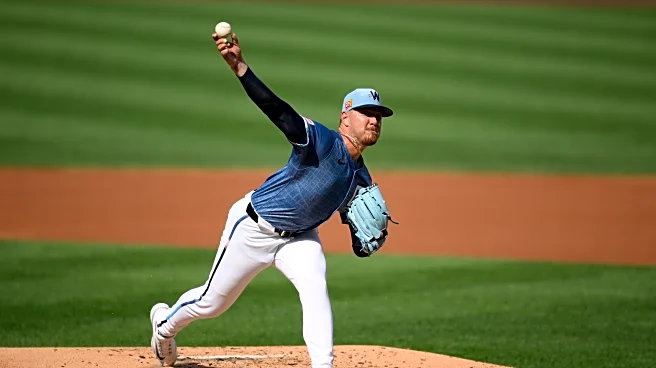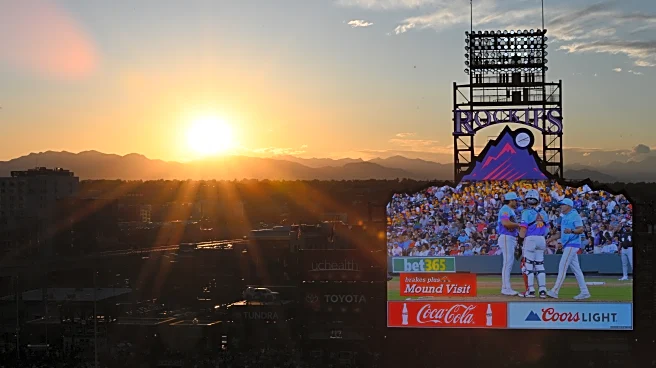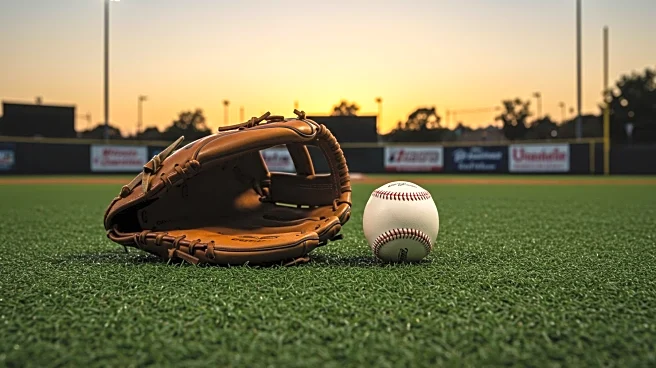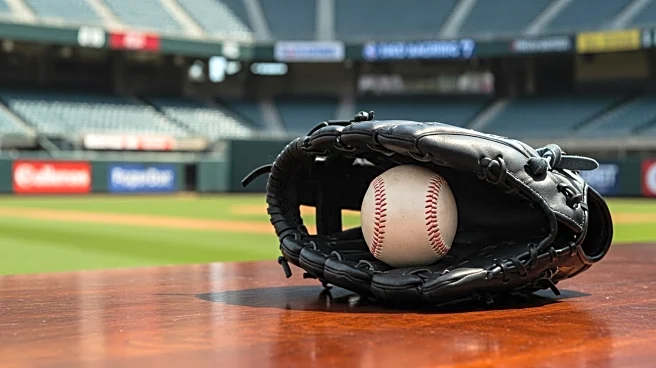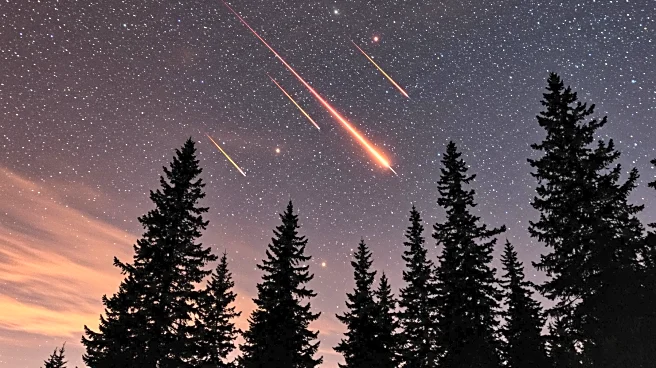
Let’s keep the mid-season 2025 Purple Row Prospects (PuRPs) list reveal rolling! Today are prospects 25-21. As a reminder, in this edition of the PuRPs poll, 23 ballots were cast, with 30 points granted for a first place vote, 29 for second, etc.
For each player on the PuRPs list, I’ll include a link to individual stats and contract status (via Baseball-Reference), PuRPs voting stats, a note on the 2025 season to date, and a scouting report from a national prospect writer where possible. For what
it’s worth, I’ll also include where I put each player on my personal ballot. All ages are as of the date the article is posted.
25. Jackson Cox (120 points, 17 ballots) — Preseason Ranking: 26— High Ballot 17, Mode Ballot 24
How did he enter the organization?
2022 Second Round, Toutle Lake HS (WA)
Why did he make the PuRPs list?
Cox was Colorado’s second-round pick in 2022, 50th overall, out of a rural high school in Washington state. To get Cox out of his commitment to Oregon, the Rockies signed the 6’2” righty starter for a $1.85 million bonus — well over the pick’s $1.54 million slot value. Cox’s calling card as a prospect is his 3,000+ RPM curveball, described as a slurve with “deep and late bite” which the 21-year-old paired with a low- to mid-90s fastball and a developing change-up in a repeatable delivery. When healthy. Which he hasn’t been much, though in 2025 we’re seeing Cox on the mound regularly again.
Cox was assigned to Low-A Fresno in 2023 for his professional debut, where he was 2.9 years younger than league average. The Rockies handled Cox carefully, never allowing him to go past four innings in a start or 65 pitches an outing in his ten games (nine starts). Nonetheless, Cox suffered an injury that required Tommy John surgery in July (as did fellow PuRPs Jordy Vargas and Gabriel Hughes), which ended his 2023 season and caused him to lose all of 2024 as well (he did pitch in fall instructs, just not an affiliated ball game).
It’s been a long road back to Fresno this year for Cox, who is still 0.8 years younger than league average. He’s made 19 starts but has been handled carefully, not passing the three inning threshold in any of those starts until June and not exceeding five innings in any of his appearances so far. In total, Cox has thrown 63 1/3 innings with a 3.84 ERA, 1.22 WHIP, 9.8 K/9 rate, and 2.6 BB/9 rate. The trajectory is good though — since a rough April, in which Cox had a 15.43 ERA, he’s posted a sub-3 ERA, including a 2.19 ERA in the last 90 days with a 52:8 K/BB ratio and 0.99 WHIP.
Here’s some video of Cox from a prospect showcase in 2022:
What do the scouts say?
Cox was ranked 17th in the system before the season by Baseball Prospectus:
Thomas Edward John surgery sidelined Cox for the 2024 campaign as well. That’s put the 50th pick of the 2022 draft on the back foot developmentally, now entering his fourth professional season with just 10 appearances under his belt. Before his injury, Cox boasted better stuff than several pitchers on this list, albeit with some struggles in holding his mechanics together. That inconsistency may have played a role in his injury to begin with, and certainly is the type of thing you’d hope to get sorted out with innings in games. His lengthy rehab places a bigger emphasis on Cox finding and retaining his more imposing fastball/curveball combo.
Cox was listed as a prospect of note by Eric Longenhagen of Fangraphs in January:
Cox, who signed for $1.85 million out of high school in 2022, was another of Colorado’s many TJ rehabbers in 2024. He has a great curveball, but his below-average fastball velocity (he was 92-94 again during instructs), movement, and vulnerable plane aren’t a great fit with that curve. He’s pitched just 31 affiliated innings and struggled with control during those.
MLB Pipeline wrote this about Cox before the season (though he’s not on their org top 30):
The early returns on Cox’s stuff coming back have been good, and it’s still his feel for spin that stands out. He has a plus curve with huge spin rates, 1-to-7 shape and sharp bite. He can run his fastball up to 95 mph with good life, and he has feel for what could eventually be an average changeup. Before he got hurt, he had worked on both a slider and a cutter to expand his arsenal.
Cox had added strength before the injury and there could be more in the tank the further removed from surgery he gets. He repeats his delivery well and has shown the ability to throw strikes with all of his offerings. This year will be about getting a full, healthy season in, with plenty of time to reach his mid-rotation ceiling.
When’s he going to get to the Rockies and how good will he be once he’s there?
Cox seems to have found his mojo this season in Low-A. The next step is to do it in the upper minors and with greater length per start. Cox will be Rule 5 eligible after 2026, so the Rockies no doubt will be looking for those markers next season. I’m guessing a High-A assignment to start the year but at least some exposure to Double-A, provided the health remains. I ranked Cox 29th on my list as a 40 FV player due to the pedigree, stuff, and a so far healthy recovery in Low-A. Cox has a foundational breaking ball to build around and that mid 90s fastball (which doesn’t have ideal shape), making him a mid-to-back-end rotation candidate if it comes together.
24. Drew Romo (154 points, 16 ballots) — Preseason Ranking: NR — High Ballot 10, Mode Ballot 10, 26
How did he enter the organization?
2020 Competitive Balance Round A, The Woodlands HS (TX)
Why did he make the PuRPs list?
Though Romo has fallen off the back of the top 100 prospect lists he was on before 2023, I’m still a believer that he’s a MLB catcher with a strong floor as a defender. Romo was the first catcher the Rockies had drafted in the top 100 picks since 1998 (he was the highest catcher the franchise has ever picked at 35th overall in 2020, signing for a slot $2.1 million bonus).
Entering 2025, Romo had exactly 45 days of MLB service time, which would normally disqualify him from consideration, but in fact some of those days were awarded to him and didn’t count towards rookie (and PuRPs) eligibility. I messed that up, so Romo wasn’t eligible for the preseason list (hence the NR for the preseason ranking). I figured that it wouldn’t matter much though, since he just needed a few days of MLB service time to exhaust his rookie eligibility, but unfortunately Romo has had a difficult year and hasn’t been up with the big club yet this season, so here he is back on the list once more.
The 23-year-old (he’ll turn 24 later this month) 6’1”, 205-pound switch-hitting backstop seemed like he’d have a big league role entering 2025, as the Rockies just had Jacob Stallings as a veteran and Hunter Goodman as an occasional emergency guy but mostly an OF/DH. Instead, Romo suffered a finger injury in spring training while sliding into a base and was sidelined until mid-May. Goodman earned the starting catcher job, while Braxton Fulford crushed the ball in Triple-A and took over the back-up job even after Stallings was released. The Rockies even selected veteran Austin Nola for a 15 game big league stint over Romo when both were healthy. It’s been a tough campaign for him.
Romo had worked his way up each stop in the full-season ball ladder by 2024 to Triple-A Albuquerque. The PCL offensive boost no doubt helped Romo to a .297/.339/.499 line in 370 PA with 14 HR among his 37 XBH, but it was still a 95 wRC+ for a 22-year-old catcher in Triple-A. That earned him an August call-up to the Show, where Romo hit an anemic .176/.208/.235 with three doubles in 16 games and 53 plate appearances, which was only a 9 wRC+ and -0.2 rWAR.
This year after the injury, Romo had a rehab assignment with the ACL team, then he was back in Albuquerque where he is still 3.8 years younger than league average. It hasn’t come together offensively for Romo this year with Albuquerque, as his .261/.330/.410 line while with six homers in 209 plate appearances while striking out 28% of the time is only a 78 wRC+. Romo has hit better this year from the right side of the plate, posting an .836 OPS against lefties (in 43 PA) vs. a .654 OPS vs. right-handers. He’s only gotten into 52 games in Triple-A, 46 as a catcher, and has five errors and two passed balls while throwing out 27% of runners.
Here’s some video on Romo hitting (from the left side) in the AFL in 2023 courtesy of Baseball America, including some slo-mo looks at the swing:
In addition, here are some of Romo’s highlights from 2024.
What do the scouts say?
Romo is ranked 17th in the system by MLB Pipeline as a 45 FV player, with a 60 grade on his defense and a 55 on the arm:
A switch-hitter, Romo has long shown a penchant for making a ton of contact from both sides of the plate. He’s overly aggressive because of those contact skills, so he rarely walks, but he also rarely strikes out. He has a tendency to chase too much, with a rare split of a 41 percent chase rate between Triple-A and the big leagues last year to go along with just a 22 percent miss rate, according to Synergy. It was a small sample, but big league pitchers did seem to take more advantage of his chase as he struck out in 34 percent of his plate appearances. He has been tapping into his power a little more consistently, though it’s always going to be contact over thump.
The work Romo did to address some throwing accuracy issues in 2023 paid off and he was back to doing a nice job against the running game in ’24. He’s a very good receiver and handles premium stuff well and seems ready to carve out a career at least as a solid big league backup.
Eric Longenhagen of FanGraphs, who had previously put Romo on his pre-season 2023 top 100 list, have dropped him down to a 40 FV player, 17th in the org:
After a couple of years during which Romo simply didn’t look like his usual self on defense (he allowed an 80% success rate on steals in 2023), things appeared more normal in 2024 as Romo’s arm looked average, and his receiving and ball-blocking did too. He posted his second consecutive upper-level season with a 104 wRC+ and made his big league debut.
Romo has the tools of a backup catcher. He’s a solid if unspectacular defensive catcher now that his arm strength has mostly returned (though his throws back to the pitcher are still odd looking), and he looked comfortable catching big league stuff late in 2024. Romo is a plus contact hitter with below-average bat speed, and his hit tool and game power both play down a bit because he’s an overly aggressive swinger. The strapping lad should play a well-rounded backup role for a very long time.
John Trupin of Baseball Prospectus ranked Romo 7th in the system in January as a 50 OFP player:
If sleep is the cousin of death, stagnation is perhaps its brother-in law. Presented with a straightforward path to big-league reps on a thin Rockies roster, Romo proceeded in an orderly fashion. His flat, contact-oriented swing was sufficient to keep pace in Triple-A Albuquerque, earning a late-season callup to take over a healthy share of backstop work. Though the Rox moved on from Elias Díaz at the trade deadline last year, their extension of veteran Jacob Stallings means Romo may be platooned or even placed in a backup role to start the season. That’s appropriate enough for the 23-year-old, whose season high in games caught is still around 80. His arm remains a weapon, gunning would-be pilferers, but Romo’s glove has fallen from “calling card” to closer to average. Though his athleticism is still above-average for a catcher, Romo is at this point bulked up to a degree that he is no longer a plus runner as he was early in his career. His physicality should allow him to muscle up for double digit big flies, and despite a grisly display of contact rates in his first few weeks of the bigs, he maintains enough bat control that he should handle big-league pitching with a low-whiff, low-walk profile in the years to come.
Romo’s profile is not an eye-catching one, but it’s unfair to denigrate it for what he’s capable of. Catchers who can establish themselves in the bigs as young as Romo are not always afforded the chance to develop offensively in the same way college backstops can. Average hitters who can catch are good catchers, and that’s a very reasonable outcome which will help his club.
Keith Law of the Athletic ranked Romo 11th in the system in February:
Romo can still really catch and has a plus arm, but he’s had some real throwing issues the last two years, so whether he can help at the position is at least a question mark until that’s resolved. His value is mostly in his defense; he has 40 in-game power, so while he makes a lot of contact, it’s not going to amount to much beyond perhaps an adequate batting average. The safe bet here is that he’s a backup, although it’s possible he can get over the erratic throwing and make so much contact, even if it’s light, to be a soft regular.
When’s he going to get to the Rockies and how good will he be once he’s there?
Romo needs to rediscover the form that had him on the cusp of a regular big-league role last year, particularly his contact ability. The defensive ability and contact profile Romo had shown before are good enough to clear the low floor needed to provide value of a MLB catcher, and he could be considerably more than that as he gets used to big league pitching. Despite the struggles this year, I placed Romo in my 40 FV tier, 21st on my list.
23. Warming Bernabel (156 points, 12 ballots) — Preseason Ranking: NR — High Ballot 2, Mode Ballot 21
How did he enter the organization?
2018 International Free Agent, Dominican Republic
Why did he make the PuRPs list?
Bernabel certainly announced his presence with authority in his first seven games in the big leagues, spanning late July to early August. In 29 plate appearances, the 6’1”, 180 pound 23-year-old corner infielder had 14 hits, among them four doubles, a triple, and three homers — which equates to a scalding .500/.517/1.036 batting line. That was enough to win Bernabel the NL Player of the Week award. Bernabel has cooled off since then, but his .304/.329/.557 (130 wRC+) production in 82 plate appearances for the Rockies this year has been worth 0.7 rWAR, which gives him the lead among PuRPs and ties him for seventh on the big league team this year.
It’s been great to see for Bernabel, who was a hot prospect known for his hand-eye coordination and aggressive approach who was signed by the Rockies for $900k out of the Dominican Republic in July 2018. A strong 2022 across Low-A and High-A got Bernabel a 40-man roster spot, but his 2022 ended after suffering a concussion in a freak-accident collision. Whether it was the concussion or another factor, Bernabel struggled mightily in 2023 in Double-A Hartford as one of the youngest players in the league, slipping to a 66 wRC+.
Then, Bernabel literally got shot in the back in an attempted robbery after the 2023 season in the Dominican Republic, fortunately not suffering any major injuries. Adding insult to that injury, at the end of spring training in 2024, the Rockies designated Bernabel for assignment and he was outrighted off the 40-man roster back to Double-A, where he was still 1.6 years younger than league average. In 506 PA with Hartford, Bernabel’s .263/.296/.359 line with nine homers among 27 extra base hits was a step up in every way from 2023, though his 88 wRC+ was still below league average.
In the off-season, Bernabel lost 20 pounds and got into better shape, which no doubt contributed to his good performance this season with Triple-A Albuquerque, where he was 3.8 years younger than league average. In 316 plate appearances with Albuquerque, Bernabel’s .301/.356/.450 line with eight homers among his 26 extra-base hits was worth 90 wRC+ in the supercharged offensive environment in the PCL. Bernabel’s low strikeout (12% of PA) and low walk (7% of PA) ethos was in full effect. After playing mostly third base up the minor league ladder, Bernabel split time there and at first base, committing nine errors in 39 games at third and two errors in 26 games at third. With the Rockies, Bernabel has mostly played first base, and that’s likely where his big-league home will be.
Here’s Bernabel’s first Coors Field homer (third overall) in the epic comeback against the Pirates earlier this month:
What do the scouts say?
Bernabel’s tough couple of years leading into 2025 meant he largely dropped off prospect radars for national scouts.
Longenhagen listed Bernabel as a prospect of note before the season:
The sweet-swinging Bernabel’s lack of plate discipline was exposed as he climbed the minors. He was removed from Colorado’s 40-man before last season, then had a bad year at Hartford.
MLB.com ranked Bernabel 24th in the system as a 40 FV player at mid-season 2024:
Bernabel has some intriguing offensive traits. His knack for finding the barrel can be a blessing and a curse. He makes a ton of contact, and even in his down year, he managed his strikeouts well. But he’s often too aggressive and registered a 40 percent chase rate in 2023. There’s hope that a middle ground can be found where he develops a better overall approach without losing his ability to do damage early in counts. Some improvements in terms of pitch recognition would help him tap into the raw power he has displayed at times.
Signed as a shortstop, Bernabel has been a third baseman-only in the pro game. His hands work at the hot corner, but he’s going to have to stay on top of his conditioning, especially with his lower half, in order to stay there.
When’s he going to get to the Rockies and how good will he be once he’s there?
Clearly, Bernabel made the most of his first week in the big leagues. The Rockies had a bit of a vacuum at first base thanks to the struggles of Michael Toglia and Bernabel is getting a chance to fill it. He’ll battle Toglia and fellow PuRP Charlie Condon (among others) for a longer look in the role next spring. A resurgence from Bernabel this year was not on my prospect bingo card, making his scintillating big league intro one of the best surprises in what has been a terrible year for Rockies fans. With 0.7 rWAR already in the bank, I couldn’t rank Bernabel lower than a 40 FV prospect (just off my list), and I hope there’s much more where that came from.
22. Jordy Vargas (163 points, 18 ballots) — Preseason Ranking: 13 — High Ballot 15, Mode Ballot 23
How did he enter the organization?
2021 International Free Agent, Dominican Republic
Why did he make the PuRPs list?
Vargas boasts a pitch mix that includes a mid-90s fastball, a potential plus curveball, a promising change, and the ability to throw them for strikes consistently. At least, he did before Tommy John surgery wiped out half of 2023 and all of 2024. An uneven and abbreviated 2025 hasn’t fully answered the question of if the arsenal is back as Vargas’ Rule 5 eligibility approaches this offseason.
Vargas was one of Colorado’s headline prospects from their January 2021 amateur free agent class, signing for $500k out of the Dominican Republic. The 6’3”, 153-pound 21-year-old right-handed starter has MLB bloodlines — he is the son of pitcher Yorkis Perez, who played in parts of nine big-league seasons for five different teams.
Vargas wowed observers in his 2022 stateside debut season split between the complex league and Low-A Fresno, then he was sent back to Fresno for 2023, where he was one of the youngest players in the California League (he’s younger than Jackson Cox, for reference). Against competition that was on average 2.9 years older, Vargas was clearly not overmatched by the competition in 64 innings across 13 starts, in which he had a 4.22 ERA with a 1.23 WHIP, 9.7 K/9 rate, and 3.4 BB/9 rate while right-handed batters hit just .202 against him. Then came the injury and a lengthy rehab process.
This season, Vargas was assigned to High-A Spokane, where he was 2.2 years younger than average, and was clearly pitch and innings limited. It wasn’t a smooth ride, as Vargas didn’t last longer than three innings in any of his 10 starts, allowing a 7.84 ERA with a 2.03 WHIP driven by a 9.1 BB/9 rate in 20 2/3 innings, though he did strike out 12.2/9 innings. The Rockies sent Vargas back down to the ACL in June, where he made four more starts, all of them four innings or less, the last of them on July 4th. Against lower level competition, the results (especially strikeouts) were a bit better (10 2/3 IP, 7 ER, 10 H, 5 BB, 2 HBP, 17 K) but wildness was still an issue.
Here’s some video of Vargas in his first ACL appearance in 2022 courtesy of Fangraphs:
What do the scouts say?
Eric Longenhagen of FanGraphs gives Vargas a 40+ FV grade (with a plus grade on the curveball) and ranks him 12th in the system:
Vargas is a loose, ultra-projectable, strike-throwing starter prospect with a curvaceous breaking ball who missed 2024 recovering from Tommy John surgery. He checks every scouting box one could hope that a young pitching prospect would check, aside from maybe his fastball shape. From ages 18 to 20, Vargas’ fastball would sit 93-95 early in outings, and he’s built and moves in such a way that he might end up throwing considerably harder as his body fills out. He’s super loose, balanced, and mechanically consistent for a pitcher his age, in the Cristopher Sánchez or Brady Singer mold in terms of build and delivery.
Vargas’ curveball is a knee-buckling parabola of death, he’s adept at creating tail on his changeup, and his general athleticism and the looseness of his arm action portend continued growth in this area. His fastball’s shape doesn’t really complement his curveball right now, and similar to Singer, it might be tough for Vargas to miss bats with his heater unless he ends up throwing really hard (he was 92-94 during instructs in the fall of 2024) or makes a change to the pitch’s shape.
Vargas is also a good bit behind the developmental curve due to the unfortunate timing of his late-2023 Tommy John, which cost him all but a handful of developmental innings during instructs. The 2025 season is technically Vargas’ 40-man platform year, but the 64 Low-A innings he pitched before he blew out in 2023 were a career high. How the Rockies handle his innings load and promotion pace in 2025 will be interesting. They’ve experienced the drawbacks of adding very young pitching to their 40-man roster too soon (Helcris Olivarez), but Vargas is very talented and fairly polished for his age, so it’s plausible he could be sniped in the Rule 5 Draft if left unprotected. He’s among the most exciting pitching prospects in Colorado’s system and has the look of a college pitcher who gets drafted in the middle of the first round.
John Trupin of Baseball Prospectus ranked Vargas 16th before the season:
Vargas is rail thin, with a whippy, over-the-top delivery that relies heavily on a picturesque 12-6 curveball that just keeps breaking beyond the reach of hitters when the 21 year old northpaw is healthy.
MLB Pipeline ranked Vargas 26th as a 40 FV player before the season, though he is no longer on their system top 30:
When he’s healthy, Vargas might be the best pitching prospect in the system in terms of being able to pound the strike zone with a solid three-pitch mix. He can command his low-90s fastball to both sides of the plate, and the carry it has in the top of the zone helps it play up and keeps hitters from barreling it up. He can get a little fastball-heavy in his pitch mix, but he was making strides in his secondary offerings, especially in focusing in on one breaking ball. Instead of trying to create a distinct slider and curve only to have them run into each other, he’s recognized that the biting slider has a real chance to be an out pitch. There’s a solid changeup in there as well.
With a narrow and slender frame, it remains to be seen if Vargas can put on weight and add strength in order to be durable enough — and maintain his stuff enough — to be a starter. There’s also work to be done in terms of professional maturity and not letting his emotions get the better of him on the mound.
When’s he going to get to the Rockies and how good will he be once he’s there?
It’s unclear what has been going on with Vargas since that July 4th appearance — injury, pitching lab development, something else? It’s possible that Vargas will pop back up for the Arizona Fall League in advance of the Rockies needing to decide on his 40-man roster protection status this offseason. I imagine the mid-rotation projection and strikeout stuff means it’s still worth protecting Vargas from the Rule 5 draft, but the long injury recovery and uneven results make this far less of a certainty than we once would have thought.
The potential of what Vargas can be is still tantalizing (and he’s still just 21), though it’s becoming less and less likely he reaches that potential. I ranked Vargas 18th on my ballot at the bottom of the 40+ FV tier, but I’m hopeful another full offseason further away from surgery will get him back on track.
21. Welinton Herrera (192 points, 19 ballots) — Preseason Ranking: HM — High Ballot 9, Mode Ballot 30
How did he enter the organization?
2021 International Free Agent, Dominican Republic
Why did he make the PuRPs list?
Herrera is probably the Rockies’ top relief prospect, especially now that fellow PuRP Jaden Hill recently exhausted his prospect eligibility. The 21-year-old 6’0” Dominican lefty reliever was a pop-up arm in 2024 in his first taste of full season ball. Herrera, who spent two years in the DSL after signing in January 2021 (in the same class as Vargas, though Herrera is younger by five months) for $200k and a season in the ACL in 2023, was a bit wild but showed bat missing stuff. That was enough to get Herrera assigned to Low-A Fresno to start 2024.
Herrera, employing a low arm slot from the left side and mid-90s velocity, was immediately dominant in full-season ball. He struck out an absurd 62 hitters (against only nine walks) in just 34 innings (16.4 K/9 rate) with a 2.38 ERA and 1.00 WHIP across 23 appearances at Fresno. Jack Etkin wrote in August 2024 about Herrera’s strong start in Fresno, in case you’d like to read more about his arsenal and Rockies’ personnel quotes about him.
Herrera was promoted to High-A Spokane in late June, where he was 3.1 years younger than league average. Against higher-level opposition, Herrera’s rate stats were less strong (4.76 ERA, 3.75 xFIP, 1.41 WHIP, 9.5 K/9, 4.4 BB/9) in 23 appearances totaling 28 1⁄3 innings, but the fact he was doing it in High-A as a 20-year-old was quite impressive. He was also quite good in the Dominican Winter League (10 IP, 1.80 ERA, 13 K, 6 BB, 7 H) against players who were on average over 10 years older.
This year, Herrera went back to Spokane, where he quickly showed he had mastered the level. In 15 appearances and 18 1/3 innings, Herrera collected 10 saves with a sparkly 0.49 ERA, 0.76 WHIP, 14.2 K/9 rate, and 2.9 BB/9 rate. The Rockies promoted him to Double-A Hartford in mid-May, where he is 3.8 years younger than league average. In 26 appearances totaling 31 innings with Hartford, Herrera has added seven more saves with a 3.19 ERA, 1.29 WHIP, 13.9 K/9 rate, and 4.1 BB/9 rate against upper minors hitters. He also represented the Rockies at the prestigious Futures Game in July, where he got the final out to record the save for the NL squad.
Here’s some video of Herrera courtesy of Fangraphs during fall instructs last year:
What do the scouts say?
Longenhagen of FanGraphs jumped Herrera all the way up to the 40+ FV tier, 13th overall in the system, putting a 70 grade on his fastball’s future effectiveness:
A slender, 6-foot tall pure reliever, Herrera spent three years in rookie ball and then exploded in 2024 as he split his season between both A-ball levels, totaling 62.1 innings in 46 games while striking out 92 and allowing just 80 baserunners. His fastball averaged about 94.5 mph during the regular season, but was 95-98 for me during Instructional League and 94-97 in the Dominican Winter League with Aguilas.
Herrera’s drop-and-drive delivery and three-quarters slot combine to create uphill angle on his fastball, making it very tough for hitters to get on top of it when he’s sitting 96-plus; that pitch had an absurd 42% miss rate in 2024. In order to hit his ceiling as a set-up man or closer, Herrera will need to improve at least one of his secondary pitches. His slider was in the 82-84 mph range during the 2024 season and instructs, but has been up in the 86-88 mph range in LIDOM, where it still lacks the finish and depth of a great slider. His changeup, often in the 87-90 mph range, tends to cut on him and finishes in vulnerable locations. Herrera’s long arm swing makes it tough to project a ton on his changeup, but even if his fastball ends up being his only impact offering, it’s going to be good enough for Herrera to be more than just a generic middle reliever. He’s a candidate for quick promotion in 2025 and is likely to be put on the 40-man after the season.
Herrera is ranked 23rd in the system by MLB Pipeline as a 40 FV prospect with a plus grade on the fastball:
Used only as a reliever, Herrera relies largely on his fastball-slider combination to go right after hitters. His fastball sits around 95 mph and touches 97 and it comes from a low three-quarters arm slot, an upshoot heater that has carry above the barrel that gets a lot of swing-and-miss. He can get too fastball-reliant and will have to keep learning to trust his 84 mph slider. It’s a pitch he has improved by more consistently staying on top of; it flashes better than average while dropping below barrels. He actually has feel for a changeup with depth, but he doesn’t throw it much.
Herrera pounded the strike zone during his time with Fresno, but he wasn’t as sharp with Spokane. He’s made adjustments before, so there’s confidence he’ll be able to become another legitimate big league bullpen piece for the Rockies.
When’s he going to get to the Rockies and how good will he be once he’s there?
The overall value that can be added by a relief arm is limited, but Herrera certainly seems like a potential late inning reliever (and he’s a lefty to boot), especially given his performance against upper minors hitters this year in Hartford. That performance is why I ranked him 13th on my list as a 40+ FV player. Herrera is very likely to be put on the 40 man roster this offseason (if not sooner) ahead of his Rule 5 eligibility and I expect him to be in the MLB bullpen mix next season.
Next, we’ll crack the top 20 of the mid-season 2025 PuRPs list!


